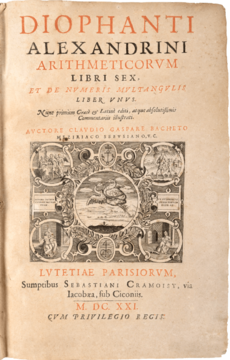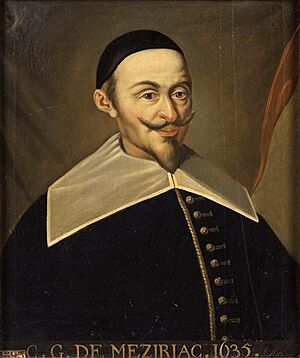Claude Gaspar Bachet de Méziriac facts for kids
Claude Gaspar Bachet Sieur de Méziriac (born October 9, 1581 – died February 26, 1638) was a clever French mathematician and poet. He was born in Bourg-en-Bresse, which was part of the Duchy of Savoy at that time.
Bachet is well-known for his books about numbers. One of his most important works was a Latin translation of an ancient Greek math book called Arithmetica by Diophantus. This very translation became famous because another mathematician, Fermat, wrote a special note in its margin about his famous Fermat's Last Theorem. Bachet also found ways to solve certain math problems called indeterminate equations and even created a method for building magic squares. He also proved an important math rule known as Bézout's identity.
Contents
Who Was Claude Bachet?

Claude Gaspar Bachet de Méziriac was born in Bourg-en-Bresse on October 9, 1581. Sadly, both his parents died when he was only six years old. After that, he was cared for by the Jesuit Order, a religious group. For about a year in 1601, Bachet was a member of the Jesuits, but he left because he became ill.
Bachet lived a comfortable life in his hometown. He got married to Philiberte de Chabeu in 1620, and they had seven children together.
Bachet's Education and Friends
Bachet studied with a Jesuit mathematician named Jacques de Billy at a college in Rheims. They became very close friends.
What Were Bachet's Main Works?
Bachet wrote several important books and papers about mathematics.
Fun Math Problems
One of his books was called Problèmes plaisans et délectables qui se font par les nombres. The first version came out in 1612, and a bigger, updated version was released in 1624. This book is a fun collection of math tricks and puzzles. Many of these puzzles are still talked about in other math recreation books today.
Translating Ancient Math
Bachet also wrote a book called Les éléments arithmétiques, which is still in manuscript form (meaning it was never officially printed as a book).
His most famous work was translating the Arithmetica by Diophantus from ancient Greek into Latin in 1621. This was a very important book because it helped mathematicians in Europe learn about Diophantus's ideas. It was in this exact translation that Fermat wrote his famous note claiming he had a proof for Fermat's Last Theorem. Bachet's translation also helped develop a new math technique called adequality, which was an early step towards infinitesimal calculus.
Solving Tricky Equations
Bachet was one of the first mathematicians to talk about solving indeterminate equations using a method called continued fractions. These are equations that have many possible answers. He also worked on number theory and found a way to create magic squares. A magic square is a grid of numbers where the numbers in each row, column, and main diagonal add up to the same total.
In the second edition of his Problèmes plaisants (1624), Bachet also proved a math rule known as Bézout's identity. He did this 142 years before another mathematician, Bézout, published his own proof!
In 1635, Bachet was chosen to be a member of the Académie française, a very respected group of French scholars.
See also
 In Spanish: Claude Gaspard Bachet de Méziriac para niños
In Spanish: Claude Gaspard Bachet de Méziriac para niños


